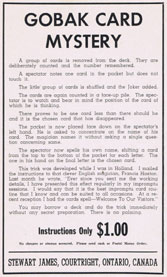

![]()
|
Card tricks can literally save lives. This dark yet redemptive story of how Stewart James created the “Gobak Card Mystery” during a moment of desperation proves how a simple deck of cards can transform into a refuge for the mind and soul. The effect is also a testament to the way in which magic and James’ life are inseparable. Even in his darkest hours, his study of the art was a constant and dependable source of solace.
Similar to the way he was able to overcome the lonely ambience of his family’s home in Courtright, James occupied himself with the invention of a magic trick to escape the depressing reality of WWII. The magician’s unusual ability to concentrate intensely upon the invention and a written description of what would later become the “Gobak Card Mystery” helped him maintain his sanity in a place where others were loosing their minds. In conditions harsh enough to induce attempted suicide, he was able to persevere and to find a positive outlet. Another example of the intimate relationship between “Gobak Card Mystery” and Stewart James’ life is evidenced by the fact that the card routine almost never made it to print. Just as some experiences are so traumatic that people actively avoid remembering them, this magic trick brought back such painful memories for its originator that he nearly forgot it completely:
In the large family of Stewart James’ innovations, this card trick is the proverbial black sheep. Notice how the above quotation refers to the routine as if it were a neglected child. Fortunately for the magic community, Francis Haxton was an enthusiastic proponent of “Gobak Card Mystery.” He adopted the trick and it was published in the September issue of The Linking Ring in 1948. If James had never written that letter, or if Haxton had not recognized the intrinsic value of the card effect, the world would have been denied a compelling trick and a fascinating personal story. But the “Gobak Card Mystery” is just one example of how the fertile mind of this magician thrived despite rigid limitations or sparse environments.
|
Copyright © 2007 Joe Culpepper and Magicana. All rights reserved.
